
|
Altmetric is a prevailing alternative metric that captures the “online mentioning” of research output from different sources (e.g. news, social media, patents, policy documents, multimedia platforms, blogs, etc.), thus providing “evidence” to demonstrate “Research Impact” beyond the academia. The “evidence” is both “quantitative” through the Altmetric Scores and “qualitative” through the links to the mentioning sources that enable researchers to identify “who”, “what”, “why” and “where” about the mentioning to trace the breadth and depth of their impact. CityUHK Scholars offers article-level Altmetric (Guide). CityUHK users can also access Altmetric Explorer for CityUHK, a library-subscribed tool that utilizes Altmetric data. Altmetric Explorer has been integrated with CityUHK Scholars, which provides verified authors, departments, and research output records. Altmetric Explorer enables users to explore and analyze data at various levels (Guide). Read more: What is Altmetric and what does it provide? |
|
| A 3-min video on "What are altmetrics?" |
To track the online attention surrounding a specific research piece, Altmetric requires three key elements:
Read more: How does it work? | Missed mentions & Reporting missed mentions
| A 4-minute video on "How to ensure attention is tracked by Altmetric?" |
After identifying a mention of the research, Altmetric gathers it with all other online attention and displays it via the Altmetric Details Page together with the Donut and Attention Score.

The Altmetric Badge (Donut) provides an at-a-glance summary of the volume and type of attention a research output has received. The donut's different colors represent the sources from which the mentions of the research output originated.
The Altmetric Attention Score, positioned at the center of the badge, provides an indicator of the amount of attention that it has received. The score is a weighted count derived from an automated algorithm. Only the FIRST mention from a source counts towards the score.
Read more: Introduction to the badge | How are outputs scored? | How is the Altmetric Attention Score calculated? | Attention sources tracked by Altmetric
By understanding Altmetric attention scores and mentions/citations across various platforms, researchers can assess the diverse influence and engagement of their research output.
^ For patent search and analysis, you can also use Patents, a free tool by Lens.org, a platform dedicated to patent records and scholarly works.
Patent Search | Patent Structured Search | Patent Search Analysis | Patent Cited By Patents Tabs | More Guides on Lens Knowledge Base - Patents
* Different tools and platforms may have different coverage. To ensure a more comprehensive tracking of cited policy documents, please also use Overton which is a database dedicated to policy citations.
 |
A sample record: 10,000-h-stable intermittent alkaline seawater electrolysis |
In CityUHK Scholars, the Altmetric badge  , if available, appears next to the research output record on the result list. Hovering over the badge reveals a summary box displaying the number of mentions or readers for each type of attention received by the research output. Clicking on the badge directs you to the record page on the Altmetric website. , if available, appears next to the research output record on the result list. Hovering over the badge reveals a summary box displaying the number of mentions or readers for each type of attention received by the research output. Clicking on the badge directs you to the record page on the Altmetric website.
View/Hide the screenshot >> |
|
|
|
Clicking on the research output title within CityUHK Scholars opens up the record page. Hovering over the Altmetric badge  triggers the display of a summary box. If you click through the badge, you will be taken to the record page on the Altmetric website for more detailed information. triggers the display of a summary box. If you click through the badge, you will be taken to the record page on the Altmetric website for more detailed information.
View/Hide the screenshot >> |
|
|
|
| On the Altmetric website, you can view sources that mention the research output by clicking on the different-colored buttons in the left panel. Alternatively, you can use the tabs for the same purpose.
View/Hide the screenshot >> |
|
|
|
| Below is an example to illustrate how it appears when you click on the "News" tab. By clicking through the News titles, you can access each of the 6 news stories from 4 outlets that have cited this research output.
View/Hide the screenshot >> |
|
|
|
| By clicking on "Explore further" on the Altmetric website, you can access the Sentiment Analysis related to the research output. This feature evaluates opinions in online mentions using artificial intelligence and a large language model. It provides sentiment scores to particular social media posts on a scale from -3 (strongly negative) to 3 (strongly positive). This helps users to determine if posts are critical, neutral, or supportive. Clicking on the sentiment scores shows related mentions.
View/Hide the screenshot >> |
|
|
Altmetric Explorer tracks mentions of research outputs across various platforms including social media, news media, blogs, Wikipedia, scholarly platforms, as well as citations in patents and policy documents. Its integration with CityUHK Scholars enables users to generate analytical reports on its dashboard for research outputs, authors, and departments at the CityUHK level and the entire Altmetric database.
Altmetric Explorer can be accessed via the Library's subscription to the research analysis & benchmarking tools (link) or via http://ezproxy.cityu.edu.hk/login?url=https://www.altmetric.com/explorer. If you are connected to the CityUHK network, you will be directed to the dashboard automatically. Otherwise, you will need to register for a personal login using your CityUHK email address. We recommend creating an account so that you can save searches, set up email alerts, create sharable reports, etc.
There is a range of search and analytical features on the Altmetric Explorer dashboard.
Watch a 1-minute video by Altmetric that introduces how Altmetric Explorer works.
| A 1-min video on Altmetric Explorer |
 Quick Search
Quick Search
Click on the "Quick Search" box in the top right corner to open a search box where you can enter a simple search query such as author name, department name, keyword, publication title, journal name, research output type, etc., to search the database. The search scope can be "Full Altmetric database" or within CityUHK's research outputs by selecting "My institution only".

 Advanced Search
Advanced Search
Click on the blue "Edit Search" button to open an "Advanced search" menu and refine the search queries at different levels. Like the quick search, you can run the searches in the full Altmetric database or within CityUHK, where the default scope can be set in "Account Settings" in the upper-right corner. To execute your search, utilize the "Run Search" button, and if needed, clear any applied filters by using the "Clear Fields" button at the bottom right corner of the page.
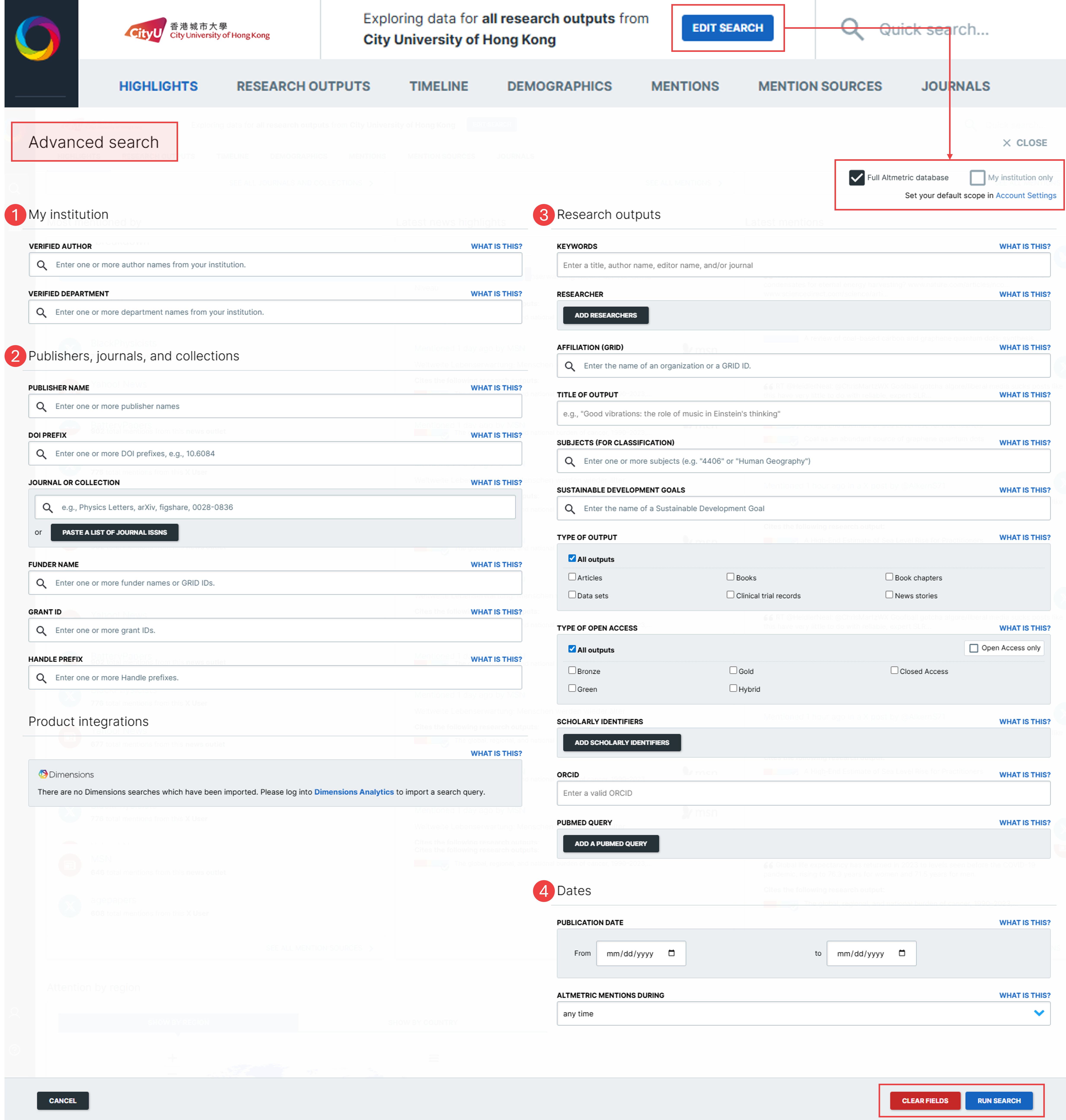
 My institution
My institution
 Publishers, journals, and collections
Publishers, journals, and collections
 Research outputs
Research outputs
 Dates
Dates
More guides
 Quick Search Quick Search |
 My Institution: Authors My Institution: Authors |
 Verified Research Outputs Verified Research Outputs |
 Advanced Search Advanced Search |
 My Institution: Departments My Institution: Departments |
 Institutional and Full Altmetric Database Filters Institutional and Full Altmetric Database Filters |

The Highlights Tab gives an overview of attention received by outputs within the full Altmetric database by default, within CityUHK or based on your crafted searches. Highlights include the attention breakdown by sources, top outputs and mention sources, latest news highlights and mentions, attention by regions, etc. Each data block is linked to another analysis tab allowing for seamless navigation and deeper investigation.
Click "Edit your search" in the upper middle section of the page to view the related Sentiment Analysis. This feature analyzes opinions in online mentions from social media using artificial intelligence and a large language model. It provides sentiment scores on a scale from -3 (strongly negative) to 3 (strongly positive), helping users assess if posts are critical, neutral, or supportive.

Below is a 1-minute video from Altmetric introducing the key features of the Highlights Tab.
| A 1-min video on Altmetric Explorer Highlights Tab |
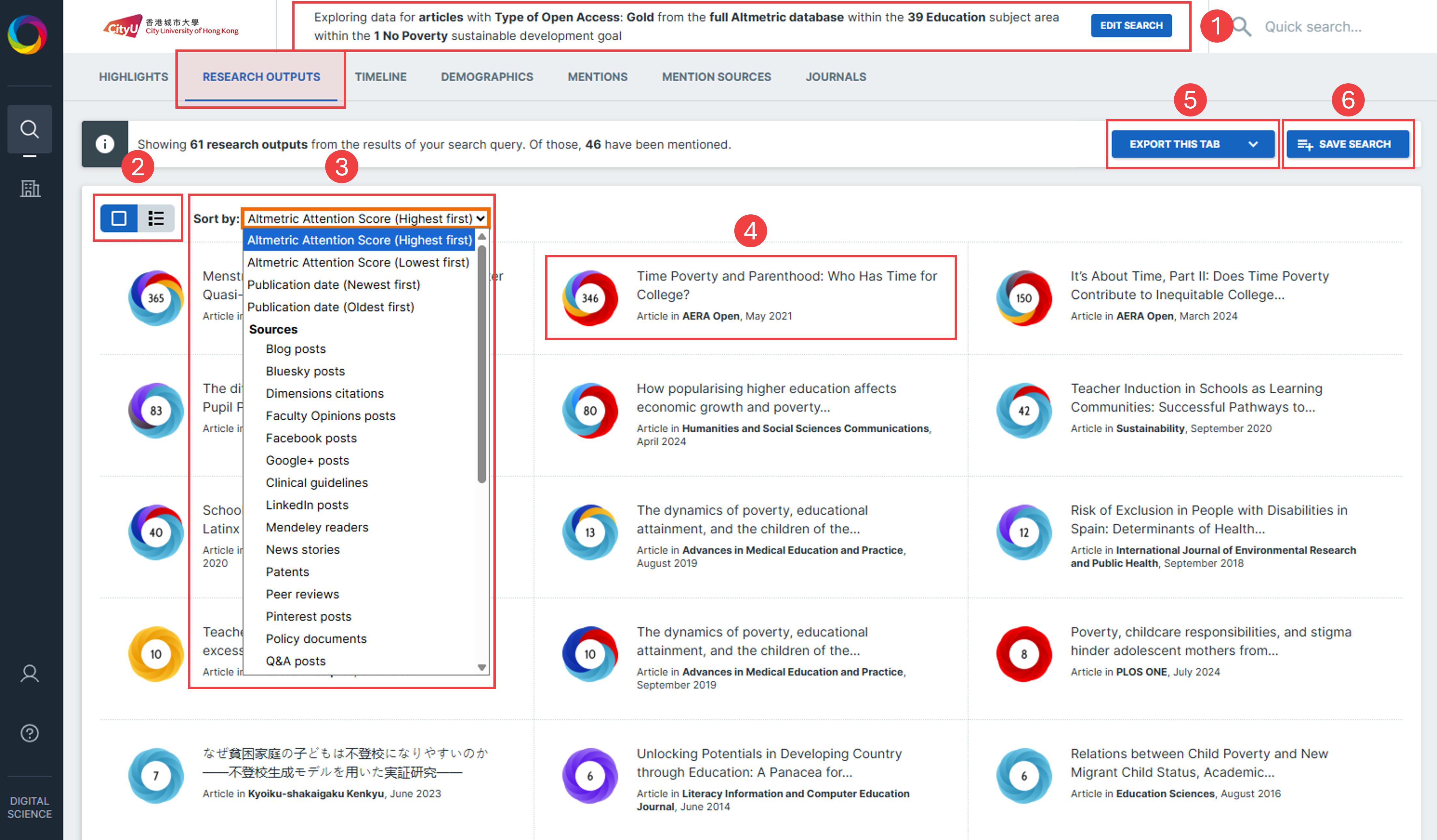
The Research Outputs Tab displays a list of research outputs based on a search query.
 The search query can be refined by clicking on the "Edit Search" button.
The search query can be refined by clicking on the "Edit Search" button.
 The research outputs are displayed in a grid view by default. Toggle the buttons to switch to the list view to see more details of an output, including its affiliations, subject areas and SDGs.
The research outputs are displayed in a grid view by default. Toggle the buttons to switch to the list view to see more details of an output, including its affiliations, subject areas and SDGs.
 Sort the results by Attention Score, sources and number of mentions.
Sort the results by Attention Score, sources and number of mentions.
 Click on the badge to open up the details page for each record.
Click on the badge to open up the details page for each record.
 Click on "Export this Tab" to export data to a CSV file for additional analysis. This button is also available under other tabs.
Click on "Export this Tab" to export data to a CSV file for additional analysis. This button is also available under other tabs.
 When logged in, click on "Save Search" to save the search for easy and future use. This button is also available under other tabs.
When logged in, click on "Save Search" to save the search for easy and future use. This button is also available under other tabs.

The Timeline Tab shows all mentions over time and filtered by specific attention source types, e.g. news, blogs, policies and patents.
 You can select one or multiple attention source types to view related mentions in the bar chart. To select multiple sources, hold down the Command key on Mac computers, or the Control key on Windows computers.
You can select one or multiple attention source types to view related mentions in the bar chart. To select multiple sources, hold down the Command key on Mac computers, or the Control key on Windows computers.
 Click the desired timeframe to view mentions by time.
Click the desired timeframe to view mentions by time.
 Alternatively, you can drag the timeline below the chart to set the period.
Alternatively, you can drag the timeline below the chart to set the period.
 To view specific mentions within a chosen timeframe and attention sources, click on a bar in the chart. This will direct you to the Mentions Tab, where you can explore the mentions within that timeframe and further refine your results using additional parameters.
To view specific mentions within a chosen timeframe and attention sources, click on a bar in the chart. This will direct you to the Mentions Tab, where you can explore the mentions within that timeframe and further refine your results using additional parameters.

The Demographics Tab shows Highcharts Maps of geolocations for the attention sources such as X, Facebook, News, Policy and Clinical Guidelines.
 To view the number of mentions and mention outlets by country, select the attention source (e.g. Policy) and hover your mouse over the country (e.g. Canada) on the map.
To view the number of mentions and mention outlets by country, select the attention source (e.g. Policy) and hover your mouse over the country (e.g. Canada) on the map.
 By clicking on the name of a country in the table (click the blue "Show More" bar for more countries), or the country on the map, you will be redirected to the Mentions Tab. There, you can explore all mentions originating from that country within the selected attention source.
By clicking on the name of a country in the table (click the blue "Show More" bar for more countries), or the country on the map, you will be redirected to the Mentions Tab. There, you can explore all mentions originating from that country within the selected attention source.
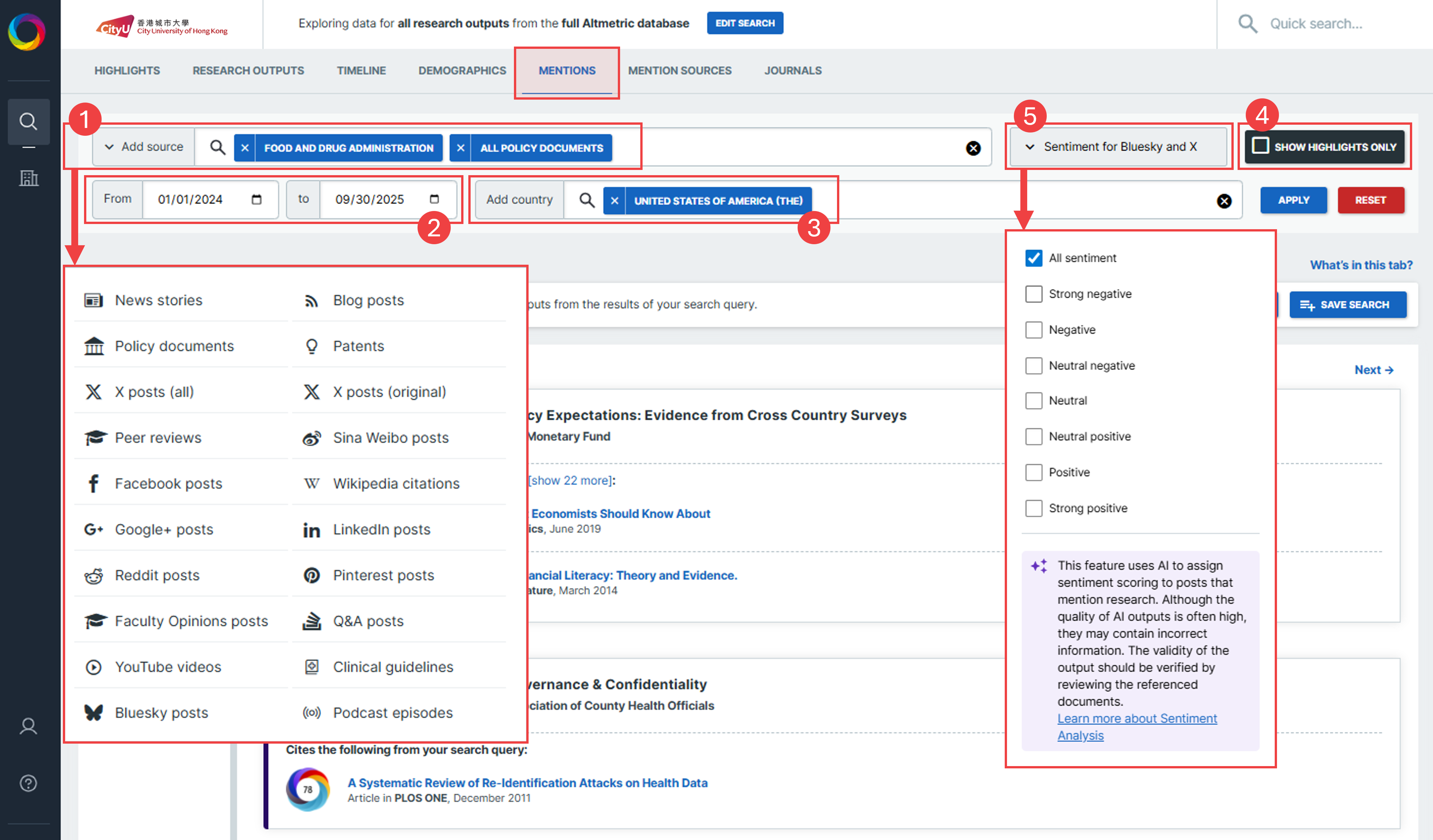
The Mentions Tab shows individual mentions across all attention sources, which can be further refined by source types, mention outlets/authors, time period or regions.
 Click "Add source" to select the attention source type (e.g. policy documents) to refine the results. Alternatively, you can key in a specific mention outlet or author (e.g. Food and Drug Administration) in the search bar, and select from the autocomplete dropdown list of suggestions. Then you can select the appropriate source that you wish to search for in the mentions results.
Click "Add source" to select the attention source type (e.g. policy documents) to refine the results. Alternatively, you can key in a specific mention outlet or author (e.g. Food and Drug Administration) in the search bar, and select from the autocomplete dropdown list of suggestions. Then you can select the appropriate source that you wish to search for in the mentions results.
 You can set the start and end date to restrict the mention results by specific mention dates.
You can set the start and end date to restrict the mention results by specific mention dates.
 You can also key in countries or regions to restrict mention results by locations.
You can also key in countries or regions to restrict mention results by locations.
 Click on "Show Highlights Only" to view internationally-recognized mainstream news attention.
Click on "Show Highlights Only" to view internationally-recognized mainstream news attention.
 You can select the specific Sentiment to restrict mention results from social media, such as Bluesky and X. Sentiment analysis analyzes opinions in online mentions from social media using artificial intelligence and a large language model. It provides sentiment scores on a scale from -3 (strongly negative) to 3 (strongly positive), helping users assess if posts are critical, neutral, or supportive.
You can select the specific Sentiment to restrict mention results from social media, such as Bluesky and X. Sentiment analysis analyzes opinions in online mentions from social media using artificial intelligence and a large language model. It provides sentiment scores on a scale from -3 (strongly negative) to 3 (strongly positive), helping users assess if posts are critical, neutral, or supportive.
More guides
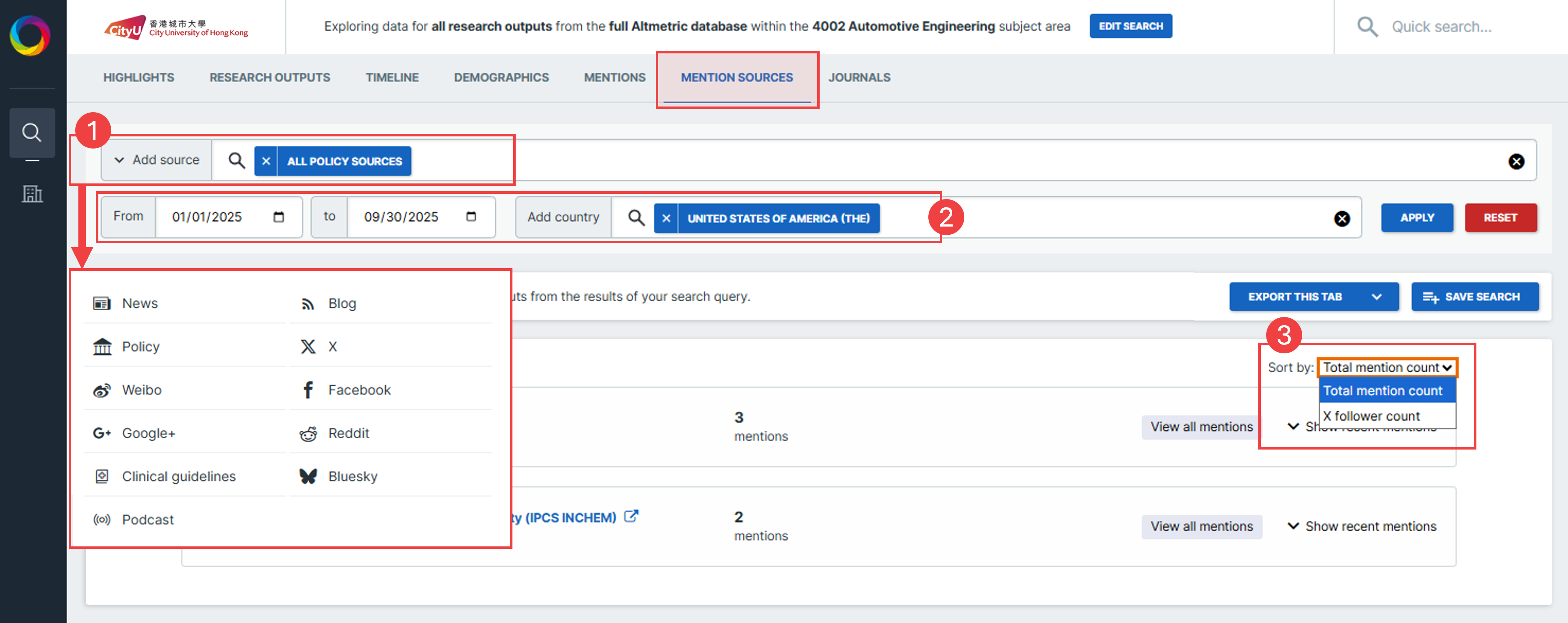
The Mention Sources Tab provides a convenient way to identify the sources and individuals (e.g. specific X users, news outlets, policy sources) that have mentioned your research the most.
 Under "Add source", you can select and view mention counts by attention source type that includes News, Blog, Policy, X, Weibo (historic), Facebook, Google+ (historic), Reddit, etc.
Under "Add source", you can select and view mention counts by attention source type that includes News, Blog, Policy, X, Weibo (historic), Facebook, Google+ (historic), Reddit, etc.
 Like the Mentions Tab, you can refine your search by specifying a time period and country/region.
Like the Mentions Tab, you can refine your search by specifying a time period and country/region.
 The results can be sorted by "Total mention count" or "X follower count". By examining the results, you can explore the organizations that mention you the most, identify the most influential X users in a specific field, and more.
The results can be sorted by "Total mention count" or "X follower count". By examining the results, you can explore the organizations that mention you the most, identify the most influential X users in a specific field, and more.
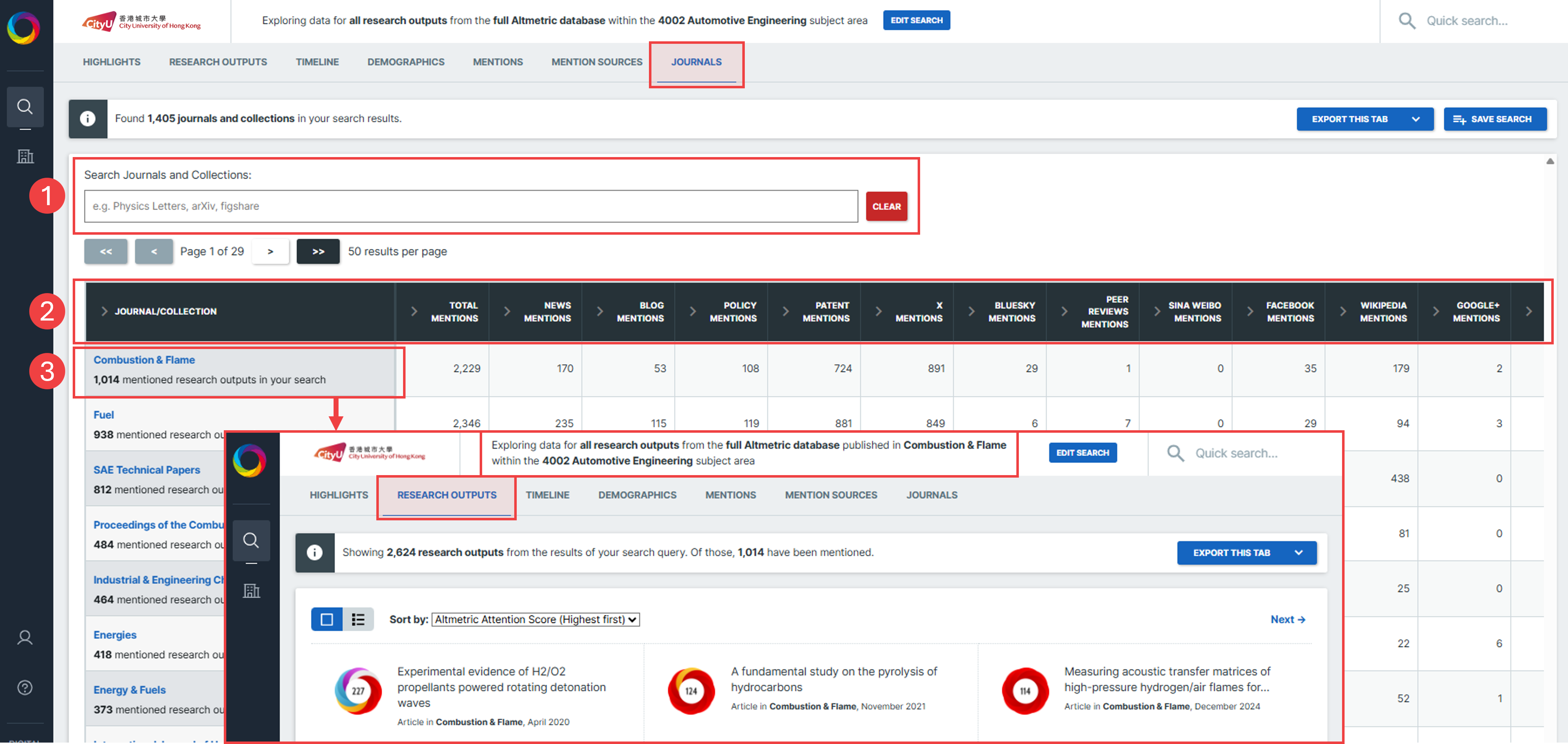
The Journals Tab presents the total number of mentions from various Altmetric attention sources based on the search query, aggregated by journal.
 You can narrow down the list by searching names and collections (e.g. Physics Letters, arXiv or figshare) under "Search Journals and Collections".
You can narrow down the list by searching names and collections (e.g. Physics Letters, arXiv or figshare) under "Search Journals and Collections".
 You can sort the entire table by clicking on each column header which allows you to sort the journals by total number of mentions and mentions by each source type.
You can sort the entire table by clicking on each column header which allows you to sort the journals by total number of mentions and mentions by each source type.
 A click through the journal title (e.g. Combustion & Flame) brings you to the Research Outputs Tab that lists all outputs published in the given journal and their Altmetric details for further analysis.
A click through the journal title (e.g. Combustion & Flame) brings you to the Research Outputs Tab that lists all outputs published in the given journal and their Altmetric details for further analysis.
Once logged in to Altmetric Explorer, the blue "Save Search" button on the right side is available under all tabs. A click through it will add your query to the "Saved Searches" dashboard.

 The "Saved Searches" is available in the left-side panel under login mode.
The "Saved Searches" is available in the left-side panel under login mode.
 Check the box to set one search as your default view when you log in.
Check the box to set one search as your default view when you log in.
 Click on any saved search to return to the results under the corresponding tab.
Click on any saved search to return to the results under the corresponding tab.
 Select to receive daily, weekly, and/or monthly email reports of the search.
Select to receive daily, weekly, and/or monthly email reports of the search.
 Click the blue document to generate a sharable report.
Click the blue document to generate a sharable report.
 Edit the search name via the green pencil, send an example email report to your login account via the blue arrow, or delete the saved search via the red X button.
Edit the search name via the green pencil, send an example email report to your login account via the blue arrow, or delete the saved search via the red X button.

Create a sharable report by clicking on the blue document icon on a saved search.

Click "Edit Report" to enter the edit mode and personalize the report.

 Click the blue buttons to add more report modules.
Click the blue buttons to add more report modules.
 Edit or delete any auto-populated modules.
Edit or delete any auto-populated modules.
 Check "Make public?" to generate a publicly-accessible version of the report that can be shared with users without access to Altmetric Explorer.
Check "Make public?" to generate a publicly-accessible version of the report that can be shared with users without access to Altmetric Explorer.
 Click "Save Changes" or "Cancel" to save or disregard the changes.
Click "Save Changes" or "Cancel" to save or disregard the changes.

Watch a 16-minute video by Altmetric that guides you through the Altmetric Explorer platform. Learn how to perform searches and analyze mentions using different tabs.
| A 16-min walk-through video about Altmetric Explorer |
Source from: Engineering, Altmetric (2020). How to Search Altmetric Explorer: An Introductory Guide for Institutions. Altmetric. Presentation. https://doi.org/10.6084/m9.figshare.11496681.v2
More guides
Altmetric Explorer Support Site: https://help.altmetric.com/support/solutions/6000139608